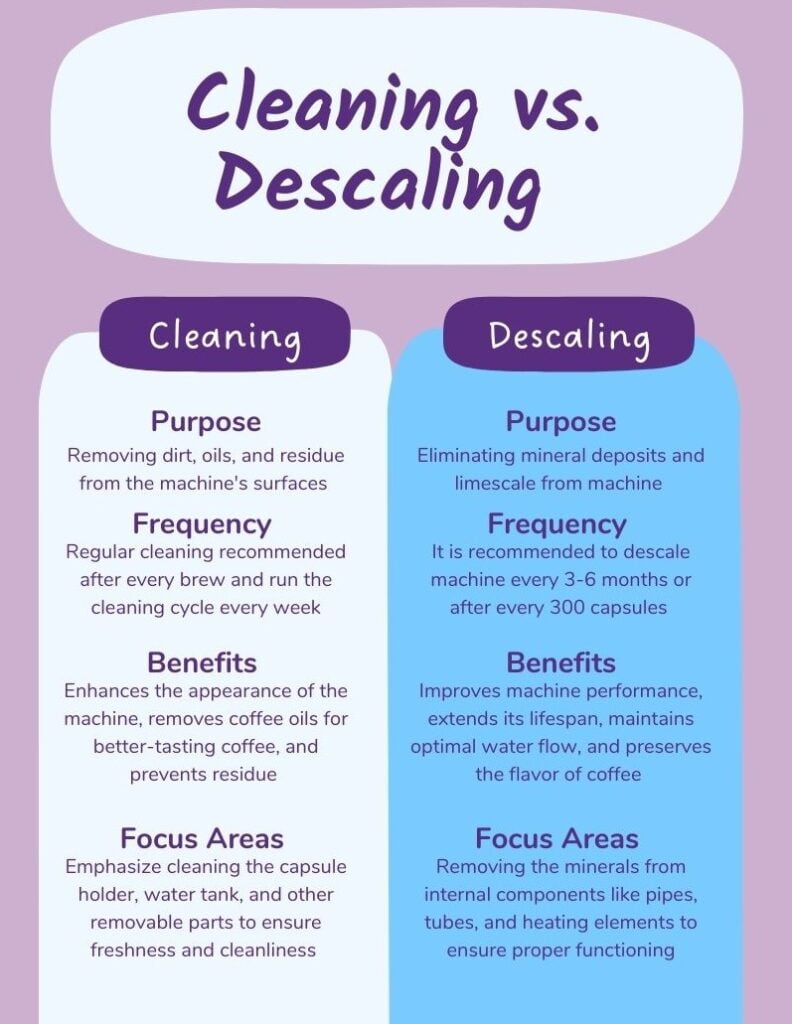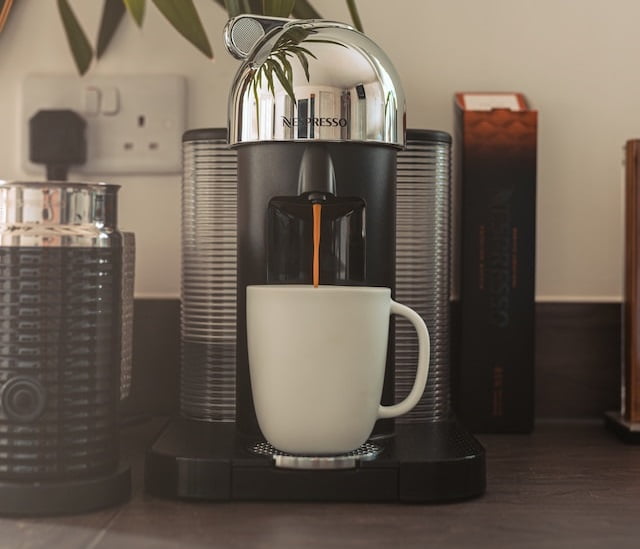Cleaning your Nespresso machine is more than just a chore; it’s a crucial step for ensuring a consistently delicious and satisfying coffee experience in the comfort of your own home.
In this article, I’ll be your guide, providing you with step-by-step instructions on how to clean the Nespresso machine and keep it in pristine condition.

As an Amazon Associate, I earn commission from qualifying purchases.
How to Do Routine Cleaning of Nespresso Machine?
Let’s get into how to keep your Nespresso machine clean on a regular basis. Before starting make sure that the machine is completely switched Off and there is no old or new coffee capsule in the brew head.
Things you’ll Need:
- Dish Soap
- Cleaning Cloth or Sponge
- Water Container
1. Disassemble the Machine
Start by Disassembling all the removable parts of your Nespresso machine.
Remove the water tank, waste capsule container, drip tray, and any other removable parts. This step ensures that no nook or cranny is left untouched.
Pro Tip: Place the small parts in a sink or container with warm soapy water while you clean the rest of the machine to prevent them from getting misplaced.
2. Clean the Water Tank
The water tank is prone to mineral deposits and bacterial growth.
Empty the tank and wash it with warm soapy water, making sure to remove any residue. Pay close attention to corners and crevices.
Rinse the tank thoroughly to eliminate any traces of soap, and allow it to air dry completely before reassembling.
3. Clean the Waste Capsule Container
The Waste Capsule Container tends to collect coffee grounds and residue. Empty it and wash it with warm soapy water. Use a soft cloth or sponge to gently scrub away any stains or build-up.
4. Wipe the Brew Head and Capsule Holder
Carefully wipe the brew head and capsule holder using a damp cloth to remove any coffee residue. Take extra care not to scratch or damage these parts, as they directly impact the extraction process.
Pro Tip: A small, soft-bristled brush or a toothbrush can be handy for cleaning hard-to-reach areas around the brew head and capsule holder.
5. Clean the Drip Tray
Remove the tray and wash it with warm soapy water. For stubborn stains, gently scrub with a soft brush.
Pro Tip: Placing a paper towel or a coffee filter in the drip tray can help absorb excess moisture and make cleaning easier.
6. Clean the Milk Forhter
If you have an advanced Nespresso machine with built-in Milk Frother, you should clean it after every use to prevent milk residue from drying and becoming difficult to remove.
To clean the milk frother, remove it from the machine and disassemble all the removable parts like the milk jug, spout, frothing tube, and the rapid cappuccino connector.
All these components are dishwasher safe, you can place these components in the upper side of the dishwasher.
If you don’t have a dishwasher, soak all the components in warm soapy water for some time and wipe them with a cloth or sponge.
At the end, rinse all the components thoroughly with fresh water and let them dry before reassembling them.
7. Wipe the Exterior with a Damp Cloth
Wipe the exterior of the machine with a damp cloth to remove fingerprints, stains, or dust. Avoid using strong cleaning agents or abrasive materials that may damage the surface.
Pro Tip: If your Nespresso machine has a stainless steel finish, wiping with a microfiber cloth can help prevent streaks and maintain its shine.
8. Reassemble the Machine
Once you have cleaned and dried all the components thoroughly, reassemble your Nespresso machine. Ensure that all parts fit securely in place.
9. Run the Cleaning Cycle
You must run a cleaning cycle at least weakly. This cycle helps remove any remaining residue from the internal parts of the machine, ensuring optimal performance.
How to Enter Nespresso Cleaning Mode?
The cleaning cycle mode differs from machine to machine. You can refer to the machine’s user manual for detailed instructions. The most common procedure is as follows:
The Original Line Cleaning cycle: Simply run four “lungo” brew cycles using water without inserting a coffee pod inside the machine.
Nespresso Vertuo Cleaning cycle: Fill the water tank with fresh water and quickly press the brew button 3 times within 2 seconds. The machine will initiate a rinse cycle that lasts between 2 to 5 minutes.
What is The Difference Between Cleaning and Descaling?
Descaling and Cleaning your Nespresso machine are two essential maintenance tasks that serve distinct purposes.
Cleaning refers to the regular removal of coffee oils, milk residue, and other particles accumulated during brewing. It involves cleaning the exterior and interior parts of the machine, including the frother, water tank, drip tray, and capsule holder.
On the other hand, descaling specifically targets mineral deposits, such as calcium and magnesium, which build up over time and can affect the machine’s functionality and efficiency.
To keep your Nespresso machine in top shape, it is important to incorporate both cleaning and descaling into your maintenance routine. This ensures a consistently great cup of coffee and prolongs the lifespan of your machine.

How Often Should You Descale Your Nespresso Machine?
It is recommended to descale your machine every 3 months or after every 300 capsules, whichever comes first.
Many Nespresso machines have a descaling alert system like a blinking orange light to remind you when it’s time for descaling. Keeping up with this maintenance routine will help you enjoy the best possible coffee experience from your Nespresso machine.
In case your machine doesn’t have an automatic alert, make sure you note the date of descaling in your notes so that you don’t exceed the limit of 3 months or 300 capsules.
It’s always a best practice to descale your Nespresso machine as soon as possible if you notice any of the following signs.
- Slow Brewing or Reduced water flow
- The machine is very loud or making unusual noises
- The Coffee tastes burnt or bitter
- Blinking lights or warning indicators
- Leakages from the brew head or bottom
- The Coffee is not as hot as it used to be
How to Descale Nespresso Machine?
Follow these steps to effectively descale your machine and remove mineral buildup
Step 1: Prepare the machine
Start by preparing your Nespresso machine for descaling. Lift and close the lever to eject any used capsules. Remove and Empty the used capsule container, drip tray, and water tank.
Once cleaned, replace the used capsule container, water tank, and drip tray back into the machine.
Step 2: Prepare the Descaling Solution
Step 3: Enter the Descaling Mode
The process may vary depending on your Nespresso machine model. Refer to your machine’s user manual for specific instructions on activating the descaling mode.
Generally for the Nespresso Original line Models like Essenza, Pixie, and Innisa, you have to press and hold both the Espresso and Lungo button for seven to ten seconds to enter the descaling mode.
And for Vertuo machines, you have to press and hold the button for seven seconds.
Read a detailed guide on Descaling Nespresso Vertuo machines
Step 4: Run the Descaling Cycle
Press the blinking button and allow the descaling cycle to run with an empty container placed under the coffee outlet. Once the machine has stopped pushing water through the outlet, the descaling process is completed.
Now fill the water tank again with clean drinking water and press the blinking button. This is the rinsing cycle, that will eliminate any remaining limescale and the remains of the descaling solution from the machine.
Step 5: Let it dry
When the descaling is complete, allow the machine to dry for 10 minutes before using it.
Tips for Cleaning Your Nespresso Machine
- Handle with Care: When cleaning your Nespresso machine, it’s important to use a soft cloth or sponge to avoid any accidental scratches on the surfaces. Avoid using any kind of abrasive cleaning material.
- Gentle Cleaning Agents: Opt for mild soapy water when cleaning most parts of the machine. Strong cleaning agents may contain harsh chemicals that can harm the delicate components of your Nespresso machine.
- Remove Used Capsules: After brewing your coffee, never leave a used capsule in the holder. Always lift the lid to eject the capsule. Otherwise, the coffee residue gets hardened around the capsule holder and makes it very hard to clean.
- Milk Frother Maintenance: If your Nespresso machine is equipped with a milk frother or steam wand, make it a habit to clean it thoroughly after each use. Milk residue can accumulate and clog the system over time, affecting the frothing performance.

Final Thoughts
All in all, maintaining a clean Nespresso machine is essential for enjoying a consistently delicious cup of coffee. By following the provided cleaning and descaling instructions, you can keep your machine in optimal condition and extend its lifespan.
If you have any questions regarding cleaning the Nespresso machine you can ask us in the comments!
Also Check out How to clean coffee stains from Cups
FAQs
Can I use vinegar to descale my Nespresso?
Yes, you can use vinegar to make a homemade descaling solution for Nespresso if you don’t have the descaling solution. Mix 500 mL clean water and 500 mL white vinegar in the water tank and start the descaling procedure.
However, vinegar leaves a very pungent smell and affects the taste of your coffee. Also, Nespresso won’t recommend using Vinegar for descaling.
What happens if you don’t clean the Nespresso machine?
If you don’t clean the Nespresso machine regularly it will accumulate coffee residue, limescale, and bacteria. This can result in decreased performance, unpleasant-tasting coffee, and unrecoverable damage to the machine.
Can you use baking soda to clean a Nespresso machine?
No, baking soda is very abrasive and can potentially damage your Nespresso machine. Stick to mild soapy water and avoid using baking soda for cleaning.




Never realized how much buildup was affecting my coffee taste! Finally got that perfect crema back. Thanks for explaining the warning signs of a machine that needs cleaning.